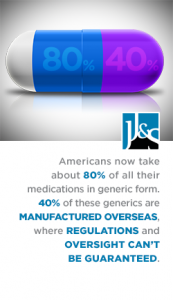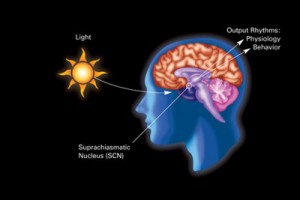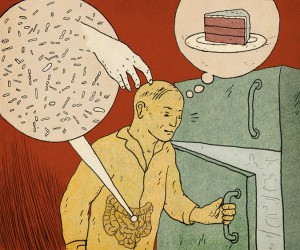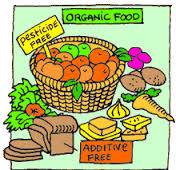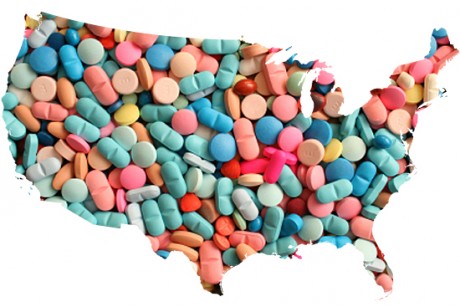Are Generic Drugs Dangerous?
3 John 1:2
Beloved, I wish above all things that thou mayest prosper and be in health, even as thy soul prospereth.
For anyone first reading the Health and Nutrition Update, please read this first: Your Health.
Also, please go to God’s Health System and subscribe to receive the updates.
Always remember that you are in charge of your health and not the doctors. Do not put your life in their hands without first seeking God and His health system.
Commentary
For years Americans have been urged to request the generic equivalent of brand name drugs whenever they’re available. There has been a heavily promoted marketing campaign to assure us that they are equivalent in all ways with the brand name drugs they’re meant to replace. The biggest reason for using generics is, of course, cost. And as long as they’re virtually the same as brand name, that’s a good incentive to switch to generics.
But with the rise of global trade, many of the medications Americans take in generic form are being produced in countries like India, where there isn’t regulation and oversight like there is in the US. If you’ve purchased generics before, believing that you’re getting the same drug in a different form, and that the only real difference is cost, think again. Even if they were “equivalent” in the past, that no longer is the case and there have been serious recalls of late, along with tests that reveal the American consumer may be gambling with his life by purchasing generics. At a minimum, the drug you get may not do what it is supposed to do; at worst, you may end up very ill or dead, depending on what the medication is for.
I’ve seen this first-hand with my cat, Hosanna (pictured here, yawning, with her brother Necco). She began her diabetes treatment with a specific generic and when I switched to any other, she would begin vomiting constantly. Thinking that was odd, I did some research and found her “generic” is actually made by Pfizer, the company who makes the brand name of the drug she takes. Because their “generic” version is actually the brand, just labeled as generic, it’s much cheaper so I’ve stuck with it. But the pharmacy has a note never to substitute her usual type for a different generic. Regardless of the advertising hype, they aren’t all the same.
Prescription Drugs
“A new analysis by the U.S. National Bureau of Economic Research reveals extensive problems with the quality of generics produced by Indian pharmaceutical companies, which supply about 40 percent of the generic drugs sold in the U.S. Bureau investigators examined nearly 1,500 India-made drug samples collected from 22 cities and found that up to 10 percent of some medications contained insufficient levels of the key active ingredients — concentrations so low, in fact, that they would not be effective against the diseases they’re designed to treat.
This new research adds to a growing body of evidence that the generic drug industry, which supplies 85 percent of the drugs sold in the U.S., routinely violates basic quality control standards and ships sub-par medicines to the U.S. and other countries.
What that means is that many patients prescribed generic drugs are not only getting ripped off, but may be at risk because their medications are not treating the conditions they have, says renowned cardiologist Chauncey Crandall, M.D.
International regulators found more than 1,600 errors in 15 drug applications submitted by the Indian generic giant Ranbaxy Laboratories Limited. Officials noted that these pills were “potentially unsafe and illegal to sell.”
The findings come in the wake of a string of drug recalls of products made by Indian pharmaceutical companies. Some 100,000 bottles of the heart drug Toprol XL were recalled because they didn’t dissolve properly. The medication is a beta blocker taken by millions of Americans to prevent strokes, heart attacks, and sudden cardiac death.
In light of these developments, Dr. Crandall says patients need to talk to their doctors about the medications they are taking.
“There is a difference when we [use] generics and it can cost the patients his life,” he says. “So at all costs I would urge [patients] to pursue the name brand drug. I think we need to make our government officials aware of this. They are pushing you to inferior drugs and we need to get a revolution going to get these inferior drugs off the market.”
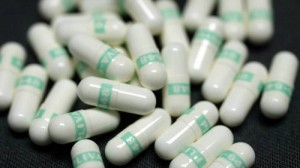
A single dose of SSRI antidepressants such as Fluoxetine, shown here, can change the brain’s functional connectivity within three hours, a new study found.
Antidepressants rapidly alter brain architecture, study finds Although advertising has downplayed or covered up the fact that antidepressants physically alter brain structure so that the person taking them becomes increasingly unable to function without them, a new study gives startling evidence of how rapidly that occurs.
“A single dose of a popular class of psychiatric drug used to treat depression can alter the brain’s architecture within hours, even though most patients usually don’t report improvement for weeks, a new study suggests.
More than 1 in 10 adults in the U.S. use these drugs, which adjust the availability of a chemical transmitter in the brain, serotonin, by blocking the way it is reabsorbed. The so-called Selective Serotonin Reuptake Inhibitors, or SSRIs, include Prozac, Lexapro, Celexa, Paxil and Zoloft.
[A] discovery in the late 1990s [showed] that low-frequency brain signaling during relative inactivity, such as daydreaming, is a good indicator of functional connectivity.
When more serotonin was available, this resting state functional connectivity decreased on a broad scale, the study found. This finding was not particularly surprising — other studies have shown a similar effect in brain regions strongly associated with mood regulation.
But there was a two-fold shock: Some areas of the brain appeared to buck the trend and become more interdependent. And all the changes were evident only three hours after the single dosage.”
Bacteria from bees possible alternative to antibiotics
“Thirteen lactic acid bacteria found in the honey stomach of bees have shown promising results in a series of studies. The group of bacteria counteracted antibiotic-resistant MRSA in lab experiments. The bacteria, mixed into honey, has healed horses with persistent wounds. The formula has previously been shown to protect against bee colony collapse.”
Actually, MSG Is Not Safe for Everyone
“A recent video from the American Chemical Society purporting to debunk myths about the food additive monosodium glutamate (MSG) led to a slew of news stories — but that coverage failed to recognize that a subset of the population should avoid MSG.
The video contains two misleading facts. The first suggests MSG is considered “Generally Recognized as Safe,” or GRAS. The GRAS label for additives gives the appearance of safety; yet the term GRAS was simply given to food additives that were in use when the Food Additives Amendment of 1958 was established. The label effectively “grandfathered in” the additives so they could bypass premarket approval by the FDA (i.e., safety testing). Secondly, the video states that free glutamate occurs naturally in some foods. This is true; however, it does not mean that MSG is safe for everyone. People who are sensitive to MSG must also avoid foods with high amounts of naturally occurring free glutamate, such as soy sauce and Parmesan cheese.”

Scientists believe that a genetic mutation, which is detectable in blood samples, makes some people more likely to kill themselves
Blood test could indicate predisposition to suicide Until now there has been no good way to discern which people are more likely to commit suicide when they’re depressed or under stress. But scientists at Johns Hopkins University School of Medicine believe they have found a genetic mutation in those more likely to take their own lives and report that they can detect this mutation with a blood test.
If other studies confirm this finding, eventually it could be used to determine which people are more at risk and tailor their treatment to minimize the risk. This could include screening in order to avoid drugs which carry a higher risk for causing suicidal ideation, such as antidepressants.
“In cases where the people had died by suicide, there was a lower-than-normal concentration of a gene known as SKA2. It plays a part in the brain’s handling of stress hormones, and if it isn’t functioning properly or is lacking, stressful situations that would ordinarily be bearable can drive a person to contemplate or even attempt killing themselves.
It was also found that the mutation not only reduced the levels of the gene, but also added chemicals called methyl groups to the SKA2 that was present.
This finding was backed up by an analysis of blood samples taken from 325 living test subjects. Based on the levels of methyl groups in the SKA2 genes within those samples, the scientists could predict with 80 percent overall accuracy which of the participants had contemplated or attempted suicide. The accuracy went up to 90 percent for test subjects who posed a severe suicide risk, and 96 percent for the youngest group of participants.”
Vitamin D
New research finds activated vitamin D regulates genes involved in the circadian rhythm
“Research from Journal of Biological Rhythms discovered that calcitriol, the activated form of vitamin D, modulated the expression of and synchronized two genes involved in the circadian rhythm in stem cells derived from fat tissue.
The circadian rhythm is an internal, entrainable biological process that predictably fluctuates over the course of 24 hours. It is involved in the sleeping and feeding patterns of animals, including humans.
Being internal means that it occurs in organisms despite any outside input. Being entrainable means that it can be reset by external influences. The circadian rhythm affects core body temperature, brain wave activity, hormone production, cell regeneration, and other biological activities.
Sunlight is a Zeitgeber which means “time giver” in German. A Zeitgeber is any external or environmental cue that entrains an organism’s biological rhythms to the Earth’s 24 hour light/dark cycle.
It is relatively known that the sun plays a major role in regulating the circadian rhythm in humans. This is one reason why night-shift workers have abnormal sleep schedules; they are not exposing themselves to the sun during the day which alters the reset of the circadian rhythm.
It is unknown, however, how the sun exactly entrains the circadian rhythm.
Therefore researchers from Mexico hypothesized that activated vitamin D may be mediating the effects of sunlight on biological rhythms.
Controlled trials in which researchers measure multiple biomarkers influenced by the circadian rhythm (such as testosterone, cortisol, melatonin) are needed to determine how vitamin D supplementation affects this process in humans.”
Gut Flora
Our Microbiome May Be Looking Out for Itself This is a very interesting article that explains not only why we have cravings for certain foods, but how other behaviors we engage in may actually be driven by promptings of our gut bacteria. It may be that they are controlling much more than what we eat.
“Maybe the microbiome is our puppet master.
In fact, there are many well-documented examples of parasites controlling their hosts. How parasites control their hosts remains mysterious. But it looks as if they release molecules that directly or indirectly can influence their brains.Our microbiome has the biochemical potential to do the same thing. In our guts, bacteria make some of the same chemicals that our neurons use to communicate with one another….
A number of recent studies have shown that gut bacteria can use these signals to alter the biochemistry of the brain. Compared with ordinary mice, those raised free of germs behave differently in a number of ways. They are more anxious, for example, and have impaired memory.
Some experiments suggest that bacteria also can influence the way their hosts eat. Germ-free mice develop more receptors for sweet flavors in their intestines, for example. They also prefer to drink sweeter drinks than normal mice do.
Dr. Maley and his colleagues argue that our eating habits create a strong motive for microbes to manipulate us. “From the microbe’s perspective, what we eat is a matter of life and death,” Dr. Maley said.
Different species of microbes thrive on different kinds of food. If they can prompt us to eat more of the food they depend on, they can multiply.
Microbial manipulations might fill in some of the puzzling holes in our understandings about food cravings, Dr. Maley said. Scientists have tried to explain food cravings as the body’s way to build up a supply of nutrients after deprivation, or as addictions, much like those for drugs like tobacco and cocaine.”
Health and Nutrition
New Study Finds Organic Diet For One Week Drops Pesticide Levels By 90 Percent In Adults
“A recent study conducted by researchers from RMIT university …found that an organic diet for just one week significantly reduced pesticide (commonly used in conventional food production) exposure in adults.
Thirteen participants were randomly selected to consume a diet consisting of at least 80% organic or conventional food for precisely 7 days, afterwards crossing over to the alternative diet from which they started. The study found that urinary dialkylphosphates (DAPs) measurements were 89% lower when they ate an organic diet for seven days compared to a conventional diet for the same amount of time.
“A lot of these agents were initially developed as nerve gases for chemical warfare, so we do know that they have toxic effects on the nervous system at high doses. Conventional food production commonly uses organophosphate pesticides, which are neurotoxins that act on the nervous system of humans by blocking an important enzyme. Recent studies have raised concerns for health effects of these chemicals even at relatively low levels. This study is an important first step in expanding our understanding about the impact of an organic diet.”
Zero-Calorie Sweeteners Can Raise Blood Sugar: Researchers
“Artificial sweeteners may do more harm than good, when it comes to diabetes. New research shows fake sugars in diet soda, yogurt, and other foods consumed by millions can raise the blood sugar level instead of reducing it.
The findings, based on experiments involving mice and people, indicate zero-calorie sweeteners such as saccharin, sucralose, and aspartame can alter the population of gut bacteria and trigger unwanted changes such as higher blood glucose levels — a risk factor for diabetes, the Wall Street Journal reports.“The scope of our discovery is cause for a public reassessment of the massive and unsupervised use of artificial sweeteners,” said Eran Elinav, a physician and immunologist at Israel’s Weizmann Institute of Science and lead author of the study, which appeared in the journal Nature.”
Migraine Relief Drink Recipe – Go Green!
“Ingredients
• 16oz filtered water or coconut water
• 1 cup pineapple
• 1 cup kale (3-4 leaves)
• 1 stalk celery
• ½ lemon, juiced
• 1 cup cucumber (about ½ a large cucumber)
• ½ inch ginger root
• 1 1/2 cups Ice
Instructions
Place all ingredients into the blender.
Secure lid and blend well for at least 60 seconds.
Note: You can omit the water and ice and extract the ingredients
with a juicer, or leave it as is for a whole food juice by keeping the fiber.
Enjoy! (Makes 2 drinks)The ingredients in this drink are very healthy and may help with headache, nausea and stomach upset. Ginger has anti-inflammatory properties, and is a potent herb that has been known to help with any type of pain or swelling of the tissues. Fresh pineapple contains bromelain, a natural enzyme that has been known to be a form of natural pain relief and anti-inflammatory as well. Cucumber is 95% water and can help with dehydration. It is thought that the chemicals in celery act to cause sleepiness, increase urine to decrease fluid retention, decrease blood pressure, decrease blood sugar, decrease blood clotting, and increase muscle relaxation.”
Pet Health
How to Choose an Omega Supplement for your Pet
Since pets also need omega fatty acids to remain healthy and not all commercial food contains them either at all or in the correct amounts, this articles lists 6 common oils used to supplement your pets’ diets, and discusses the benefits of each. It thoroughly discusses the subject of oils to give you as much information as possible so you can make the most appropriate choice for your dog or cat. While there isn’t a set ratio of omega 3 to 6 that is standard, generally you should look for a ratio of 8:1 or more.
“Step 1: Evaluate your pet’s health
All pets can greatly benefit from an omega supplement as not all foods provide omega fatty acids, and not all foods provide the optimal ratio of them. There are some definite tell tale signs that your pet is experiencing a deficiency in omega fatty acids. You will typically notice the following:
• Dull coat color, lacking a radiant sheen
• Dry, flaky, cracked skin
• Suffers from allergies
• Experiences joint stiffness and joint painMany people only supplement omega fatty acids for skin and coat health, but the benefits are far reaching. Omega fatty acids are critical to proper brain function, retina function, a reduction of harmful inflammation throughout the body, and the daily maintenance and production of cell walls.
Step 2: Learn the difference between Omega 3’s and Omega 6’s
One of the most important things you need to know is that omega-3’s produce an anti-inflammatory response within the body, while omega-6’s produce an inflammatory response within the body. This is why the ratio between them is so important, and should be taken into consideration when choosing a product to supplement. Many pets (and humans) suffer from an omega-3 deficiency.
Step 3: Choose your source of Omega Fatty Acids
Now that you know what the omega fatty acids are, and where they come from, you can select which supplement you need, and how you want to administer it to your pet. “
Conclusion
Your physical health is very important, but of even greater importance is your spiritual health. Man suffers from a fatal spiritual disease called sin, which always leads to death. Romans 6:23 For the wages of sin is death; but the gift of God is eternal life through Jesus Christ our Lord.


